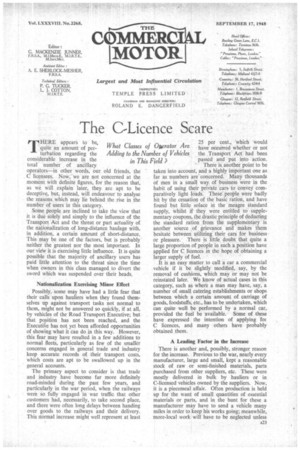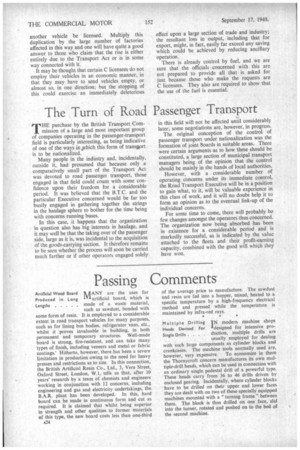The C-Licence Scare
Page 25

Page 26

If you've noticed an error in this article please click here to report it so we can fix it.
THERE appears to be, quite an amount of perturbation regarding the considerable increase in the total number . of ancillary operators—in other words, our old friends, the C licensees. Now,-we are not concerned at the moment with definite figures, for the reason that, as we will explain later, they are apt to be deceptive, but, instead, will endeavour to analyse the reasons which may lie behind the rise in the number of users in this category.
Some people are inclined to take the view that it is due solely and simply to the influence of the Transport Act and the threat or part actuality of the nationalization of long-distance haulage with, in addition, a certain amount of short-distance, This may be one of the factors, but is probably neither the greatest nor the most important. In our view it is exercising little influence. It is quite possible that the majority of ancillary users has paid little attention to the threat since the time when owners in this class managed to divert the sword which was suspended over their heads.
Nationalization Exercising Minor Effect Possibly. some may have had a little fear that their calls upon hauliers when they found themselves up against transport tasks not normal to them, might not be answered so quickly, if at all, by vehicles of the Road Transport Executive; but that poisition has not been reached, and the Executive has not yet been afforded opportunities of showing what it can do in this way. However, this fear may have resulted in a few additions to normal fleets, particularly as few of the smaller concerns engaged in general trade and industry keep accurate records of their transport costs, which costs are apt to be swallowed up in the general accounts.
The primary aspect to consider is that trade and industry have become far more definitely road-minded during the past few years, and particularly in the .war period, when the railways were So fully engaged in war traffic that other customers had, necessarily, to take second place, and there were often long delays between handing over goods to the railways and their delivery. This normal increase might well represent at least 25 per cent., 'which would have occurred whether or not the Transport Act had been passed and put into action. There is another point to be taken into account, and a highly important one as far as numbers are concerned. Many thousands of men in a small way of business were in the habit of using their private cars to convey comparatively light loads. These:people were badly hit by the cessation of the basic ration, and have found but little solace in the meagre standard supply, whilst if they were entitled to supplementary coupons, the drastic principle of deducting the standard ration from the supplementary is another source of grievance and makes them hesitate between utilizing their cars for business or pleasure. There is little. doubt that quite a large proportion of people in such a position have applied for C licences in the hope of obtaining a larger supply of fuel.
It is an easy matter to call a car a commercial vehicle if it be slightly modified, say, by the removal of cushions, which may or may not be reinstated later. We know of actual cases in this category, such as where a man may have, say, a number of small catering establishments or shops between which a certain amount of carriage of goods, foodstuffs, etc., has to be undertaken, which can quite well be performed by a normal car, provided the fuel be 'available. Some of these have expressed the intention of applying for C licences, and many others have probably obtained them.
A Leading Factor in the Increase There is another and, possibly, stronger reason for the increase. Previous to the war, nearly every manufacturer, large and small, kept a reasonable stock of raw or semi-finished materials, parts purchased from other suppliers, etc. These were mostly delivered in bulk by hauliers or in C-licensed vehicles owned by the suppliers. Now, it is a piecemeal affair. Often production is held up for the want of small quantities of essential materials or parts, and in the hunt for these a manufacturer may have to send a vehicle many miles in order to keep his works going; meanwhile, more-local work will have to be neglected unless another vehicle be licensed. Multiply this duplication by the large number of factories affected in this way and one will have quite a good answer to those who claim that the rise is either entirely due to the Transport Act or is in some way connected with it It may be thought that certain C licensees do not employ their vehicles in an economic manner, in that they may have to send vehicles empty, or almost so, in one direction; but the stopping of this could exercise an immediately deleterious effect upon a large section of trade and industry; the resultant loss in output, including that for export, might, in fact, easily far exceed any saving which could be achieved by reducing ancillary operation.
There is already control by fuel, and we are sure that the officials concerned with this are not prepared to provide all that is asked for just because those who make the requests are C licensees. They also are required to show that the use of the fuel is essential.




















































































